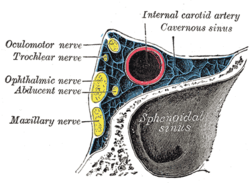Carotid-cavernous fistula
Editor-In-Chief: Prab R Tumpati, MD
Obesity, Sleep & Internal medicine
Founder, WikiMD Wellnesspedia &
W8MD medical weight loss NYC and sleep center NYC
| Carotid-cavernous fistula | |
|---|---|

| |
| Synonyms | N/A |
| Pronounce | N/A |
| Specialty | N/A |
| Symptoms | Pulsatile exophthalmos, conjunctival chemosis, diplopia, headache |
| Complications | Vision loss, cerebral hemorrhage |
| Onset | Sudden or gradual |
| Duration | Variable |
| Types | N/A |
| Causes | Trauma, aneurysm, arteriosclerosis |
| Risks | Head injury, connective tissue disorders |
| Diagnosis | Angiography, CT scan, MRI |
| Differential diagnosis | Cavernous sinus thrombosis, orbital cellulitis, thyroid eye disease |
| Prevention | N/A |
| Treatment | Endovascular therapy, surgery, radiation therapy |
| Medication | N/A |
| Prognosis | Variable, depends on severity and treatment |
| Frequency | Rare |
| Deaths | N/A |
]
]
A carotid-cavernous fistula (CCF) is an abnormal connection between the carotid artery and the cavernous sinus, a venous structure located at the base of the skull. This condition can lead to a variety of symptoms and complications, making it an important topic in the field of neurology and vascular surgery.
Causes[edit | edit source]
CCFs can be either congenital or acquired. Congenital CCFs are present at birth and are usually associated with certain genetic conditions. Acquired CCFs, on the other hand, are typically caused by trauma, such as a head injury or a car accident. Other possible causes include certain medical conditions, such as atherosclerosis or connective tissue disorders.
Symptoms[edit | edit source]
The symptoms of a carotid-cavernous fistula can vary depending on the severity of the condition. Common symptoms include:
- Proptosis (bulging of the eye)
- Redness and swelling of the eye
- Double vision or other visual disturbances
- Headache
- Eye pain
- Auditory symptoms, such as pulsatile tinnitus
Diagnosis[edit | edit source]
Diagnosing a carotid-cavernous fistula usually involves a combination of medical history, physical examination, and imaging tests. A thorough evaluation of the patient's symptoms and medical history is important in order to determine the likelihood of a CCF. Physical examination may reveal signs such as proptosis or a bruit (abnormal sound) over the affected artery. Imaging tests, such as angiography or magnetic resonance imaging (MRI), can provide detailed information about the location and severity of the fistula.
Treatment[edit | edit source]
The treatment of a carotid-cavernous fistula depends on several factors, including the severity of symptoms, the underlying cause, and the patient's overall health. In some cases, conservative management may be sufficient, involving close monitoring of the condition and symptomatic treatment. However, more severe cases may require intervention. Endovascular treatment is a common approach for CCFs. This involves the use of catheters and embolic materials to block the abnormal connection between the carotid artery and the cavernous sinus. Surgical treatment may also be considered in certain cases, particularly if the fistula is large or complex.
Complications[edit | edit source]
If left untreated, carotid-cavernous fistulas can lead to various complications. These may include: - Vision loss or blindness - Intracranial hemorrhage - Neurological deficits - Infection Therefore, early diagnosis and appropriate management are crucial in order to prevent these complications.
See also[edit | edit source]
References[edit | edit source]
Search WikiMD
Ad.Tired of being Overweight? Try W8MD's physician weight loss program.
Semaglutide (Ozempic / Wegovy and Tirzepatide (Mounjaro / Zepbound) available.
Advertise on WikiMD
|
WikiMD's Wellness Encyclopedia |
| Let Food Be Thy Medicine Medicine Thy Food - Hippocrates |
Translate this page: - East Asian
中文,
日本,
한국어,
South Asian
हिन्दी,
தமிழ்,
తెలుగు,
Urdu,
ಕನ್ನಡ,
Southeast Asian
Indonesian,
Vietnamese,
Thai,
မြန်မာဘာသာ,
বাংলা
European
español,
Deutsch,
français,
Greek,
português do Brasil,
polski,
română,
русский,
Nederlands,
norsk,
svenska,
suomi,
Italian
Middle Eastern & African
عربى,
Turkish,
Persian,
Hebrew,
Afrikaans,
isiZulu,
Kiswahili,
Other
Bulgarian,
Hungarian,
Czech,
Swedish,
മലയാളം,
मराठी,
ਪੰਜਾਬੀ,
ગુજરાતી,
Portuguese,
Ukrainian
Medical Disclaimer: WikiMD is not a substitute for professional medical advice. The information on WikiMD is provided as an information resource only, may be incorrect, outdated or misleading, and is not to be used or relied on for any diagnostic or treatment purposes. Please consult your health care provider before making any healthcare decisions or for guidance about a specific medical condition. WikiMD expressly disclaims responsibility, and shall have no liability, for any damages, loss, injury, or liability whatsoever suffered as a result of your reliance on the information contained in this site. By visiting this site you agree to the foregoing terms and conditions, which may from time to time be changed or supplemented by WikiMD. If you do not agree to the foregoing terms and conditions, you should not enter or use this site. See full disclaimer.
Credits:Most images are courtesy of Wikimedia commons, and templates, categories Wikipedia, licensed under CC BY SA or similar.
Contributors: Prab R. Tumpati, MD



